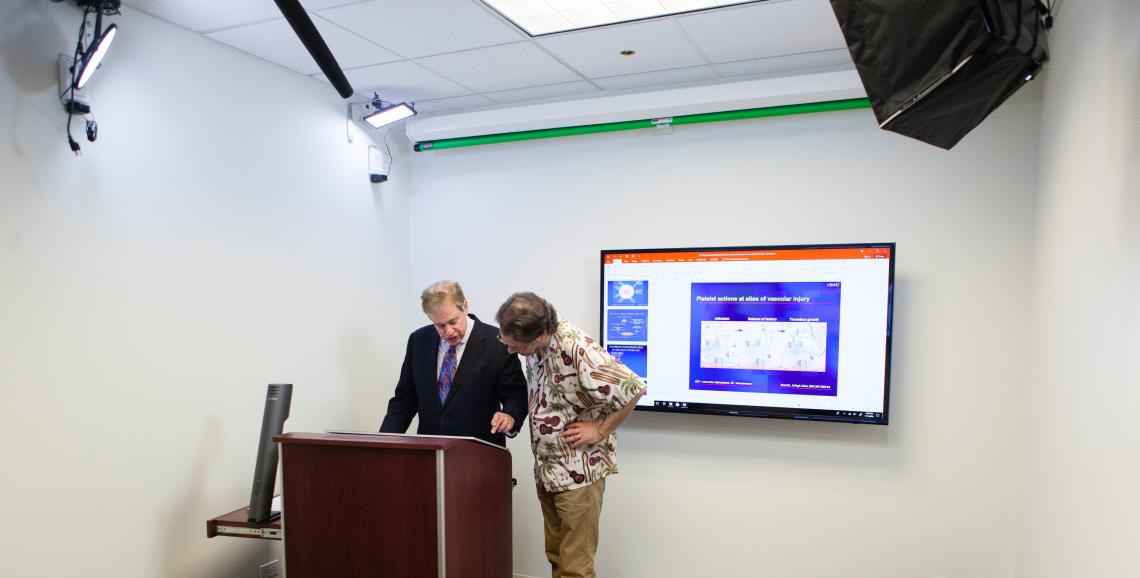About a year ago, Associate Dean for Curriculum Dr. Pat Garcia initiated an external review for the Northwestern Feinberg School of Medicine. While the review reported overwhelmingly positive results, there were a few aspects of the program that the staff wished to improve. One of those areas was “content delivery,” a dry term for an important aspect of the school. For years, Feinberg students have been taking advantage of lecture capture videos of instructors teaching at the podium. These videos have allowed students to watch the lectures on their own time and to go back and review material easily. But to date, they were simply recordings of classroom lectures and not curated the same way that they were actually being used. To improve the delivery of these imporant pedagocial tools, Dr. Garcia created a Curriculum Quality Improvement Plan to include the creation of new didactic instructional videos with the overarching goal of incorporating more in-person, active learning/application sessions without increasing total in-class time.
To begin the process, a Learning Design Team was created with Jim Brucker as the lead along with instructional designer, Laura Seul, and Blended Curriculum expert, Matthew Aron, from Teaching & Learning Technologies. The team’s goals were to address both design and technology in the curriculum. They knew they needed to follow the basic design principles of online instruction like piecing the years of material into smaller chunks, making the video accessible in small formats (like a cellphone screen) and of course, organizing the material in a way that made sense in an asynchronous format. This also lead to the building of a new studio based on the popular One Button Studios on the Evanston campus. “It’s more of an Eight Button Studio,” jokes Jim, the Director of Instructional Design & Development in the Department of Medical Education. He talks about the importance of the collaboration with the instructor. “I really try to partner with the faculty. One great advantage is we have all these videos from the past view years and get to know their style. I get a feel for how they lecture and how that might transfer to a recording.”
Jim Brucker helps prepare a faculty member to record a lecture in the FSM Studio
The Learning Design Team also collaborated with faculty on things like PowerPoint. Jim notes that his colleague, Laura, is quite gifted at graphic design. She reviewed PowerPoints to ensure they were easy to read and provided good contrast for viewing, a commonly overlooked element. Another aspect of the plan was literally creating a level playing field. Many of the classrooms contained stadium-style seating. Those seats are perfect for a passive classroom lectures, but of course that was exactly what the program was moving away from. They flattened the floor, allowing for more modular seating that facilitates group work and interaction between students.
The Curriculum Quality Improvement Plan also included an Ed Tech Toolbox, which provided a variety of ways for instructors to present their material. They could choose to film their video lessons using their desktop and Panopto; film in the studio; or they could use the Lightboard on the Evanston campus. They also had the usage of two types of student response systems, both Nearpod and TurningPoint. “The video lessons as pre-work is very helpful,” said Pat, reiterating a common theme of programs that use videos to free up class time for group work and active learning that helps students retain and comprehend material more deeply, something we all want our future doctors to do. Since late summer 2017, 23 faculty in the M1 curriculum (the first year of medical school) have converted lectures to video lessons, and 27 faculty converted lectures in M2. With over 150 students in each program, the impact has been far-reaching. Statistics indicate that the students are returning to videos to review material over time, and surveys of students showed a marked increase in the quality of the presentation of materials.
The changes in the M1 and M2 program illustrate how effective it can be to partner with instructional designers and to think about your “content delivery” in a deliberate and thoughtful way. Consider ways that you can provide didactic information outside the classroom and free up classtime for group collaboration and hands-on work.

